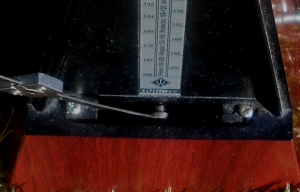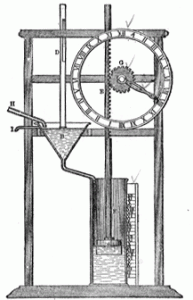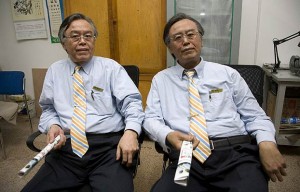The present object, at its face, has a triangular shaped side, measured at 7.6 inches tall. At the height of this measurement, the object is sectioned off by a perfectly leveled horizontal indentation that yields to a pyramid shaped portion at .3 inches tall that crowns the remaining portion of the body. At the objects peak, it stands at 7.9 inches tall. The slope of the triangle shaped side is roughly 101 degrees from base to apex.
The object has 4 sides of uniform dimensions equal to the side measured above. When looking at the bottom of the object, when it is turned with it’s apex, at the top of the pyramid shape, pointing downward, we see that the base is squared. Each side of the square, at the bottom of the object, measures at 4.5 inches. Its weight is measured at 330g.
The first component seen on this object is the indentation at what we can presume is the objects front. From 3.4 inch to 7.4 inch marks from the bottom of the object’s face is where this indentation occurs, measured at roughly .3 inches deep into the object’s front. This indentation has a black triangular shaped finish on what appears to be treated plastic. On either side of the triangle are groves following, perfectly, the original triangle shape of the object.
Directly center of this area, resting vertically, is a metal strip . It is thin with several grooves in it, and measured perfectly starting at the bottom and occurring more rapidly as we scan its features to its top. This piece is not attached to this area, rather, if we follow its origination, and maneuver the whole object so that the apex of the triangle is pointing at us, we see a rectangular shaped hole where the object’s point of origination extends from (see image l). The rectangular hole measures about a third of the indentation in the whole object, and extends about half of the indented area’s base, centered, at 3.4 inches on the slope from the base of the object.

Enclosed around the metal strip, and made similar material, is a pitchfork shaped device with three prongs. The outer prongs of this device hug the metal piece and are thick, whereas the thinner piece, the center prong, is positioned directly atop the metal piece, so that the areas of the metal strip are not visible wherever the center prong rests. They seem to latch on to the grooves of the metal piece and the pitchfork device can be moved to the desired position on the many grooves. The metal piece, at its very top, is housed within a ridge on the indented section. When the metal piece is removed from this housing at its top it snaps forward from the front of the object and swings from one side to the next.
The final piece of the indented portion of the object is located directly underneath the metal piece. It is an additional indentation that is colored gray. It extends the same height as the metal piece but is markedly wider. The component that is most notable of this area is the printed and underlined numbers. The underlines correlate in position with the groves of the metal strip — so that the top number, 40, is underlined very closely to where the first groove of the metal strip begins, when housed in the ridge; and the next number from the top, 42, correlates with the following groove of the metal strip.
Each concurrent number appears on the opposite side of the metal strip, on the final indentation, and they are lowered so that 40 is higher and on the left side (from our perspective) of the metal piece compared with 42; while 42 is higher than and on the right side of the metal piece compared with 44. (40 and 44 are both on the left side of the metal piece).
At the bottom of the final indentation appears to be a pitchfork shaped figure enclosed in a black diamond. Underneath the diamond is the word “Wittner,” presumably the objects maker.
The object, excluding the indentation mentioned previously, appears to be made of a mahogany finish. It has several black striations from bottom to top and it resembles a wooden finish. This finish reveals itself to be a hard plastic by its smooth surface when touched and inspected further. On the the object’s left side, if we presume the indented area is the front, there is a metal knob that makes a click noise when turned, and the noise resonates from the interior of the object, in an area that, to be inspected, would require dismantling the entire object to view the mechanism causing the clicking noise. This knob, presumably, winds up the thin metal piece in the indentation, and when it is wound, it powers the metal strip’s swings, and provides force for the strip to oscillate at different rates, depending on the position of the pitchfork shaped device on the ridges on the metal piece.
The higher the pitchfork shaped device is on the metal strip, the slower it operates — so that 208, the number lowest on the final indentation, swings the metal strip faster than 40, the number highest on the final indentation. Whenever the metal strip crosses the center, where it is housed, it makes the clicking noise described earlier. These clicks can be timed, when maneuvering the pitchfork device, enclosing the thin metal piece in the indentation, downward or upward, and synchronized with the second hand of a clock — or faster and slower.
The final piece we will inspect is the “Wittner” inscription on the final indention, underneath the black diamond shape that houses the pitchfork shape (not to be confused with the pitchfork shaped device that encloses a portion of the metal strip). A quick internet search of the inscription coupled with the object’s description yields promising results. Wittner is a German manufacturing company that specializes in various musical auxiliary equipment. Filtering through the items in which our object is not, in its aspects of shape, size, and color, we find that our object is a Wittner made metronome Model No. 812 K, plastic casing (see image ll).

This object is not specific to the maker Wittner. Johann Maelzel is one of the early, and questionable, inventors of the modern metronome, but the design of early model components are accredited to Galileo, who first discovered the practical uses modern clock mechanisms.
Maelzel’s professional history is intertwined with Beethoven’s composition of the “Wellington’s Victory,” a composition that Maelzel commissioned the pianist to write and that was eventually performed on another contraption of the inventor’s, the panharmonicon. But after a bitter battle with the composer over legal ownership of the “Wellington’s Victory,” Maelzel, while on a world tour, died aboard the Otis en route to Philadelphia from Havana — but his contribution lasted.
Despite Maelzel’s German lineage, the term metronome actually comes from Greek. It is a combination of the words metron (measure) and nomos (relegating). Whether the ancient Greeks had any notion of developing a metronome predating Maelzel’s model is unknown, but archaeological history reveals that ancient Greece utilized various early time-keeping devices. One of these devices is called the water clock (see image lll).

Water clocks, though used by many ancient cultures, originated in Egypt around two thousand B.C. These clocks were powered by a water container, that, when emptied into a reservoir, lifted a floating device attached to handle. This handle, attached to a gear directly above it, rose as water filled the reservoir and turned the gear which controlled the movement of a clock dial that made up much of the device’s face. When the water in the supply container ran empty, and the reservoir was filled, the clock stopped and both devices would have to be restored in situ; that is, the container must be refilled, and the reservoir must be emptied . This design required constant manipulation by the ancient Greeks to keep the clocks running, but the goal, if kept, would provide an accurate measure of time elapsed. For this purpose, the water clocks calculated time more precisely than the obelisk, which ancient cultures used with ubiquity, largely due to obelisks’ functioning relegated to daylight hours — they relied on casting shadows determined by the sun’s position in the sky.
The intricate taxonomy of early Greek and ancient Egyptian water clocks begot innovation in the centuries following that led to the invention of the clock, as they are today, and other peripheral chronometrical inventions such as the Wittner metronome Model No. 812 K, plastic casing.
This particular metronome assisted in the composition process of an alto saxophone and piano piece that won first prize at the 2011 Ohio Federation of Music Clubs’ Composition Competition collegiate level. The young man who won the competition began playing the piano at thirteen years of age. During his artistic infancy, he practiced fourteen hours a day, measuring his notes and discerning the distinct taste the staccato and legato flavor a piece of music. His daily schedule deferred to his practice schedule and he committed to the precedent routine with brief rests throughout the day, the naps supplementing the lack of major REM sleep. This schedule would change depending on what time his bus would carry him to his middle and, later, high school classes. He initially learned pieces of music by ear, playing crude renditions of Handel and fumbling through advanced chord progressions of Thelonious Monk.
He exhibited a singular interest in classical and jazz music that distinguished him from his peers. His appetite for the thrill of practicing, however raw, lead him to pursue a richer knowledge of the artistry of composition and arrangement. At fifteen years old, he studied under his first piano instructor who would refine his artistic capabilities. On Tuesdays and Thursdays, at seven o’clock, he would meet with his instructor to develop his ability to read measures of sheet music. Immediately, the instructor was captivated by the student’s quick knowledge and measured understanding of the classics.
He was advised, after a brief stint into his guided direction, by the instructor to seek a more advanced teacher. That year, during his first semester of tenth grade, he heeded his former instructor’s advice and he went on to study under a master class pianist who, over the progression of her advisement, would suffer bouts of disorientation and forgetfulness that accompanied dementia that she suffered in her aged years. Nevertheless, the relationship was a fruitful one and the student decided to attend Shorter University in Rome, Georgia (the city’s name commemorates the Italian city with the same name) in remote appreciation of Italian composer, Antonio Vivaldi.
The student performed well under the tuition of his professors at Shorter, and he graduated three years after he first entered the program. He amassed a comprehensive repertoire with works ranging from early classical to later twentieth century, and many of his own compositions (some of which he entered into competition and won). He then went on to pursue his master’s degree at Cincinnati Conservatory of Music after studying in Austria, the “capital of classical music,” where he learned that composition better suited his interest. There, in his second and final year at CCM, he wrote the piece that would win him the 2011 Ohio Federation of Music Clubs’ Composition Competition collegiate level, and placed him in an excellent position to pursue his DMA at Cornell University in Ithaca, New York, and after his sojourn in this city (named after Odysseus’s refuge in Homer’s Odyssey) there is no way of knowing what direction his musical journey will take him.
The Wittner metronome, Model No. 812 K, plastic casing, accompanied the student in much of his journey, from Rome, Georgia, to Austria; from Cincinnati to Ithaca; and It was used to aide in the preparation of many pieces before garnering the mentioned win. Prior to its current ownership, it was shipped from Allgäu, Germany, according to Wittner’s shipping address.
If this metronome will ever be encased in glass, like Beethoven’s famed metronome from his landmarked house in Baden, Austria, (see map below) is too early to deduct; but there are millions of metronomes, many similar to Model No. 812 K, plastic casing, in use today measuring the practice of aspiring, and accomplished, musicians that may be curated to exhibits such as Beethoven’s .
The Model No. 812 K, plastic casing, may very well be an anachronism with the most recent metronomic devices being digital and found online. They range from traditionally standard (40 to 208 beats per minute [bpm]) to technologically advanced digital interfaces that measure time at 900bpm.
Various measures of time are useful to what flavor of music is being created. The 72bpm in “Kaneda’s Death, Pt.2 (Adagio in D minor)” from the 2007 science fiction film Sunshine, is unique from the 140bpm in Beyonce’s “Drunk in Love,” which, in turn, is unique from the faster 380bpm, at its peak, in John Coltrane’s “Giant steps.” The difference in tempo can be culture and genre specific and may provide abstract insight on the culture attributed to them (high energy 1970s disco tracks tend to have faster tempos than the religiously rigid 17th century baroque pieces).
The metronome simply measures time and a key component of many traditional metronomes is the pendulum. The pendulum on a metronome is a thin, oscillating piece that emits a clicking noise as it crosses the center line of the object. (This pendulum was described earlier in our model as the thin metal piece). Galileo Galilei developed this piece in the early 17th century, but its full functionality came later that century with the invention of the pendulum clock by Christiaan Huygens. Galileo played a major role in scientific revolution during the European Renaissance, a movement that was concerned with ordering the nature.
The clock maintains its basic function, as it has since prehistoric Egypt, with their invention of the obelisk, and that function is to track time.
Although the ancient obelisks were designed to designate the most adequate and productive farming time for the early Egyptians, through the objects’ shadow casting under sunlight, our present mode of life is not disparate from the early Egyptian’s ideas of adhering to the order, or rather, the ordering, of time.
The Model No. 812 K, plastic casing, and its analogues, function reveals the nature of music; and that is, music is a sequence of sounds moving through time. Differences in pattern are in music that reflect the performer or writer or the overarching cultural notions that make up any particular piece, but the principal objective is to utilize the time. Like the ancient Egyptians whose timepiece tracked the growth of their crops, or the pianist that practiced fourteen hours a day to improve his skill, society’s daily occurrences are measured progression, or stagnation, through time — the Egyptian farmland is either tilled or not, but time continues to move.
We are able to order ourselves with time. From limitations in statutes and time stipulations in international treaties, to the more commonplace and, oftentimes, fleeting occurrences in our world, such as the aging of the piano instructor, our lives revolve around the passage of time. We can, in that time, become pianist, inventors, or farmers — or an innumerable host of desirable persons driven by a range of motivations.
This notion of employing the passage of time to optimize human utility, chronicled earlier with the student pianist and the metronome, and that humans are governed by time, the Egyptians and their crops, is condensed, at its essence, in the functionality of the metronome (that the object measures timing to aide in the production of the most suitable composition for its composer) yet the piece must remain in accordance with the parameters of time. The character’s mentioned (the Egyptians, the Greek, the disco music, the baroque music, Beethoven, Maelzel, the student, and his two instructors) all adhered to time, whether or not they were aware, to produce an output — or reap the consequences of it — some more socially and culturally impactful than others. Nevertheless, they were able to impact in some way or another and are comparable to the pieces of music, at their embryonic stage, measured by the metronome, and by time in general, in that it is an laborious task to compose a product worthy to be called symphonic if time is not administered properly, and with the desired flavor, yet something must be created lest time be wasted.
It is an elusive, garbled, and all inclusive concept with many components all seeming to compound upon the whole, repeat what has occurred, and connect dissimilar units.



